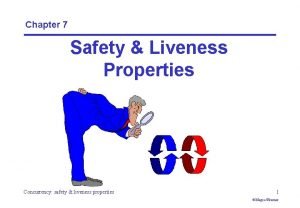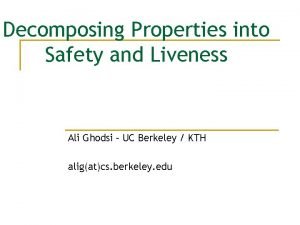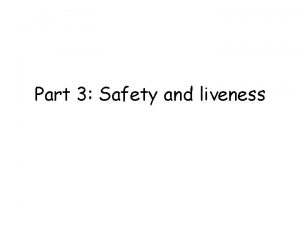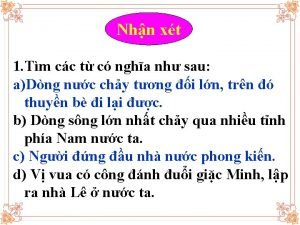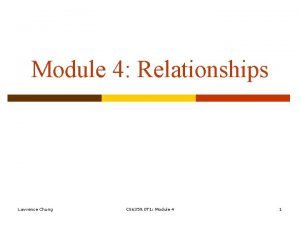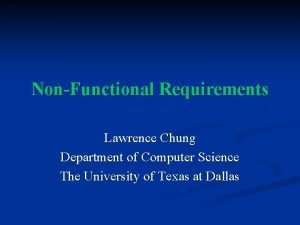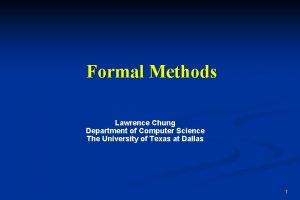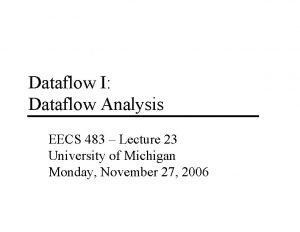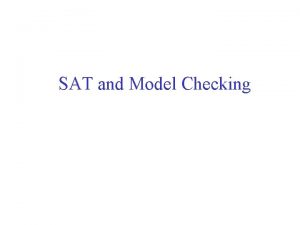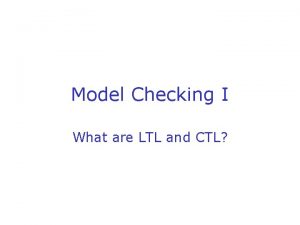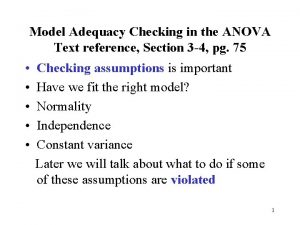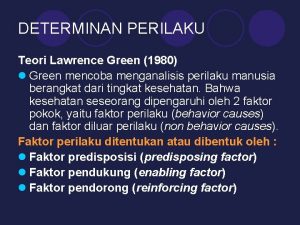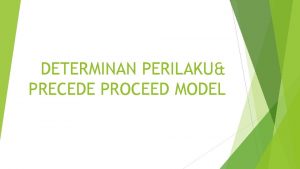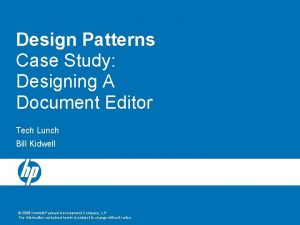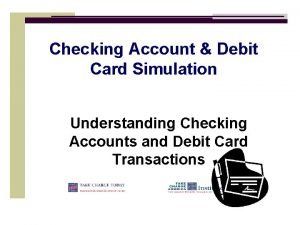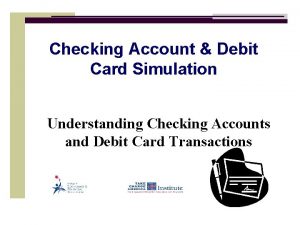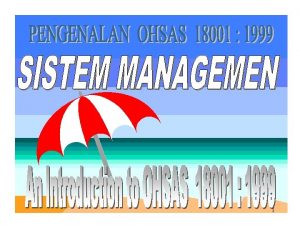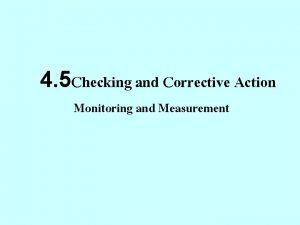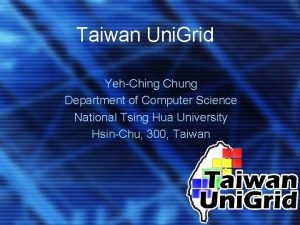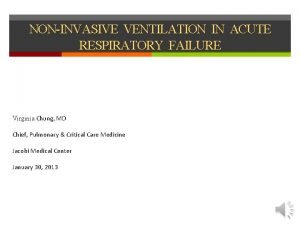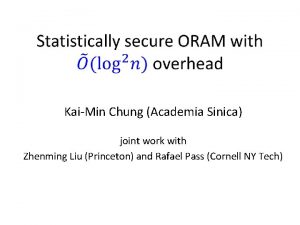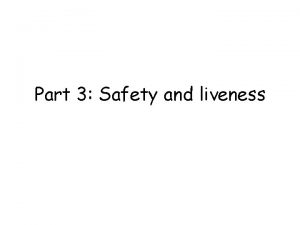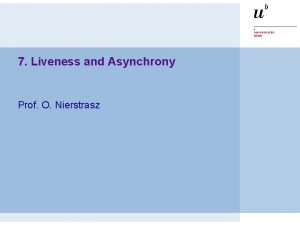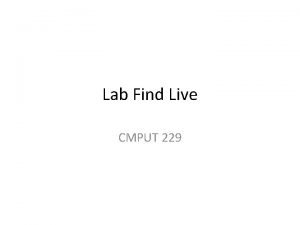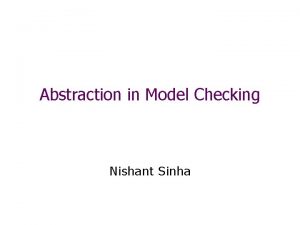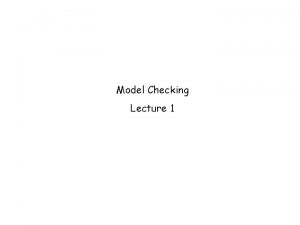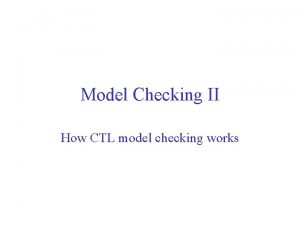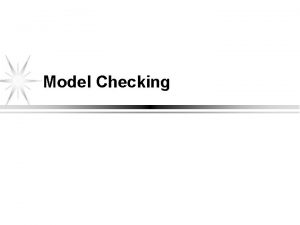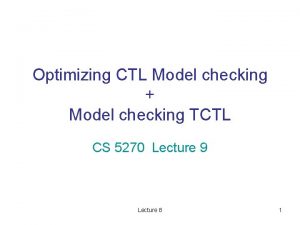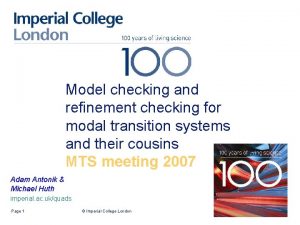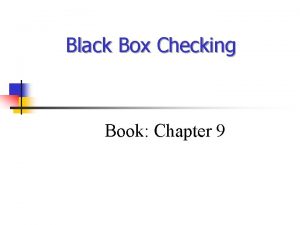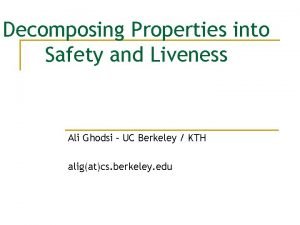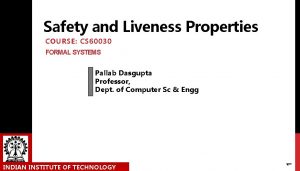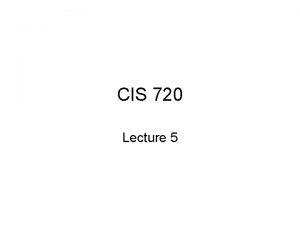Model Checking Lawrence Chung Safety and Liveness Safety


![Model Checking Process [ Adapted from www. lix. polytechnique. fr/comete/seminar/1 -Model. Checking. ppt] Model Model Checking Process [ Adapted from www. lix. polytechnique. fr/comete/seminar/1 -Model. Checking. ppt] Model](https://slidetodoc.com/presentation_image/1d8cd0487f441de8f0bdb3829d51ae89/image-3.jpg)

































- Slides: 36

Model Checking Lawrence Chung

Safety and Liveness • Safety properties – Invariants, deadlocks, reachability, etc. – Can be checked on finite traces – “something bad never happens” • Liveness Properties – Fairness, response, etc. – Infinite traces – “something good will eventually happen” Lawrence Chung 2
![Model Checking Process Adapted from www lix polytechnique frcometeseminar1 Model Checking ppt Model Model Checking Process [ Adapted from www. lix. polytechnique. fr/comete/seminar/1 -Model. Checking. ppt] Model](https://slidetodoc.com/presentation_image/1d8cd0487f441de8f0bdb3829d51ae89/image-3.jpg)
Model Checking Process [ Adapted from www. lix. polytechnique. fr/comete/seminar/1 -Model. Checking. ppt] Model Answer: (System Requirements) Specification (System Property) Model Checker M╞ φ Yes, if model satisfies specification Counterexample, otherwise For increasing our confidence in the correctness of the model: q Verification: The model satisfies important system properties q Debugging: Study counter-examples, pinpoint the source of the error, correct the model, and try again Lawrence Chung 3

Mutual Exclusion Example Model (System Requirements) The Model (Willem Visser, http: //ase. arc. nasa. gov/visser/ASE 2002 Tut. Software. MC-fonts. ppt) • Two process mutual exclusion with shared semaphore • Each process has three states • Non-critical (N) • Trying (T) • Critical (C) • Semaphore can be available (S 0) or taken (S 1) • Initially both processes are in the Non-critical state and the semaphore is available --- N 1 N 2 S 0 N 1 T 1 S 0 C 1 S 1 C 1 N 1 S 0 || N 2 T 2 S 0 C 2 S 1 C 2 N 2 S 0 Lawrence Chung 4

Mutual Exclusion Example Model (System Requirements) The Model (Willem Visser, http: //ase. arc. nasa. gov/visser/ASE 2002 Tut. Software. MC-fonts. ppt) • Initially both processes are in the Non-critical state and the semaphore is available --- N 1 N 2 S 0 N 1 T 1 S 0 C 1 S 1 C 1 N 1 S 0 || N 2 T 2 S 0 C 2 S 1 C 2 N 2 S 0 N 1 N 2 S 0 T 1 N 2 S 0 N 1 T 2 S 0 T 1 T 2 S 0 C 1 N 2 S 1 N 1 C 2 S 1 Lawrence Chung C 1 T 2 S 1 5 T 1 C 2 S 1

Mutual Exclusion Example Specification (System Property) Specification – Desirable Property No matter where you are there is always a way to get to the initial state K ╞ AG EF (N 1 N 2 S 0) Kripke structure CTL (Computation Tree Logic) M╞ φ Lawrence Chung 6

Mutual Exclusion Example Model (System Requirements) N 1 N 2 S 0 T 1 N 2 S 0 N 1 T 2 S 0 T 1 T 2 S 0 C 1 N 2 S 1 C 1 T 2 S 1 N 1 C 2 S 1 T 1 C 2 S 1 Specification (System Property) K ╞ AG EF (N 1 N 2 S 0)Lawrence Chung Model Checker M╞ φ Answer: Yes 7

Mutual Exclusion Example Answer: Yes A Proof: For All possible behaviors N 1 N 2 S 0 T 1 N 2 S 0 N 1 T 2 S 0 T 1 T 2 S 0 C 1 N 2 S 1 C 1 T 2 S 1 N 1 C 2 S 1 T 1 C 2 S 1 Lawrence Chung 8

Mutual Exclusion Example N 1 N 2 S 0 T 1 N 2 S 0 N 1 T 2 S 0 T 1 T 2 S 0 C 1 N 2 S 1 C 1 T 2 S 1 N 1 C 2 S 1 T 1 C 2 S 1 N 2 S 0 T 1 N 2 S 0 N 1 T 2 S 0 T 1 T 2 S 0 C 1 N 2 S 1 C 1 T 2 S 1 Lawrence Chung N 1 C 2 S 1 T 1 C 2 S 1 9

Mutual Exclusion Example N 1 N 2 S 0 T 1 N 2 S 0 N 1 T 2 S 0 T 1 T 2 S 0 C 1 N 2 S 1 C 1 T 2 S 1 N 1 C 2 S 1 T 1 C 2 S 1 N 2 S 0 T 1 N 2 S 0 N 1 T 2 S 0 T 1 T 2 S 0 C 1 N 2 S 1 C 1 T 2 S 1 Lawrence Chung N 1 C 2 S 1 T 1 C 2 S 1 10

Mutual Exclusion Example Specification – Desirable Property No matter where you are there is no way to get to the initial state ⌐ K ╞ AG EF (N 1 N 2 S 0) Lawrence Chung 11

Mutual Exclusion Example Answer: No N 1 N 2 S 0 Counterexample T 1 N 2 S 0 N 1 T 2 S 0 T 1 T 2 S 0 C 1 N 2 S 1 C 1 T 2 S 1 N 1 C 2 S 1 T 1 C 2 S 1 N 2 S 0 T 1 N 2 S 0 N 1 T 2 S 0 T 1 T 2 S 0 C 1 N 2 S 1 Lawrence Chung C 1 T 2 S 1 N 1 C 2 S 1 T 1 C 2 S 1 12

Defining Models Model (System Requirements) q Kripke Structure K = < S , P, R > (M = < S , P, R, L (, {s 0})>) (s 0 S - initial state) - S: the set of possible global states - P: a non-empty set of atomic propositions {p 1, . . . , pk} which express atomic properties of the global states, e. g. , being an initial state, being an accepting state, or that a particular variable has a special value. - R⊆ S × S: a transition relation s. t. R(s, s') if s to s' is a possible atomic transition - L: S → 2 P: a labeling function which defines which propositions hold in which states. -State explosion problem: The size of S is often exponential in |requirements/design|. q Model checking problem: A model checker checks whether a system, interpreted as an automaton, is a (Kripke) model of a property expressed as a temporal logic formula. K |= φ Lawrence Chung 13

Defining Models q For a complex real-life control systems Extended Finite State Machine (EFSM) - FSM with a way to -modularize the requirements to view them at different levels of detail -combine requirements (or design) of components - state variables and facilities in guards on transitions. Lawrence Chung 14

Defining Specifications Specification • Temporal Logic (System Property) – Express properties of event orderings in time – e. g. “Always” when a packet is sent it will “Eventually” be received v Linear Time v Branching Time – Every moment has a unique successor – Infinite sequences (words) – Linear Time Temporal Logic (LTL) – Every moment has several successors – Infinite tree – Computation Tree Logic (CTL) Lawrence Chung 15

Linear Temporal Logic (LTL) http: //en. wikipedia. org/wiki/Linear_temporal_logic q LTL Syntax – a set of proposition variables p 1, p 2, . . . , – the usual logic connectives and – the following temporal modal operators: • N/X for next; • G/ □ for always (globally); o Next cycle (-) previous cycle • F/ ◊ for eventually (in the future); • U for until; • R for release. q One can reduce to two of those operators since the following is always satisfied: • F φ = true U φ • G φ = false R φ = F φ • ψ R φ = ( ψ U φ) Lawrence Chung 16

Linear Temporal Logic (LTL) q. LTL (Informal) Semantics Textual Symbolic Explanation Diagram Unary operators: N φ Next: φ has to hold at the next state. (X is used synonymously. ) G φ Globally: φ has to hold on the entire subsequent path. F φ Finally: φ eventually has to hold (somewhere on the subsequent path). Binary operators: ψ U φ Until: φ holds at the current or a future position, and ψ has to hold until that position. At that position ψ does not have to hold any more. ψ R φ Release: ψ releases φ if φ is true until the first position in which ψ is true (or forever if such a position does not exist). Lawrence Chung 17

Linear Temporal Logic (LTL) Model http: //www. cs. utah. edu/classes/cs 6964/lectures/15: 10_18/timo-latvala/timo 7. pdf v. A (nondeterministic) Büchi automaton as a model of a LTL formula v. A (nondeterministic) Büchi automaton A is a tuple (∑, S, S 0, ∆, F), where • ∑ is a finite set of alphabets, • S is a finite set of states, • S 0 S is a set of initial states, • ∆ S×∑×S is the transition relation, and • F S is the set of accepting states. X p 1 as Büchi Automaton (�◊p 1)) → (�◊p 2) as Büchi Automaton p 1 U p 2 as Büchi Automaton Lawrence Chung 18

Linear Temporal Logic (LTL) q LTL Semantics – M, |= p q – M, |= Op if p L( 0) if M, |≠ p if M, |= p and M, |= q if M, |= p or M, |= q if M, 1 |= p – M, |= p if i≥ 0: M, i |= p – M, |= �p if i≥ 0: M, i |= p – M, |= p. Uq if i≥ 0: M, i |= q and j<i: M, j |= p – M, |= p. Rq if i≥ 0: M, i |= q or i≥ 0: M, i |= p and j≤i: M, j |= q M |= p if n. The Lawrence Chung (M): M, |= p satisfiability problem of LTL is PSPACE-complete. 19

Linear Temporal Logic (LTL) q safety properties: something bad never happens (G φ) Every counterexample has a finite prefix such that, however it is extended to an infinite path, it is still a counterexample. q liveness properties: something good keeps happening (GFψ or G Fψ)). Every finite prefix of a counterexample can be extended to an infinite path that satisfies the formula. • Safety Examples Ø []({ready. Signal == 1} → (){ack. Signal == 0}) - This assertion states "Always, ready. Signal equals one implies ack. Signal equals zero on the next cycle". – It makes use of the Always operator (the box) and the Next Cycle operator (the empty parentheses pair). Ø []({ready. Signal == 1} → (-){ack. Signal == 0}) This assertion states “Always, ready. Signal equals one impliesack. Signal equals zero on the previous cycle“ – Makes use of the previous cycle operator (-) - • Liveness Example Ø ◊({out 1==1} && ()()[]{out 2 < 2} && (-){out 3==0}) – This assertion states "Eventually, out 1 will equal one, and then two cycles later and always after that, out 2 is less than two and on the previous cycle out 3 equals zero. – This example uses the Eventually operator (the diamond <>), the always operator (the box []), and the Next and Previous Cycle operators (the empty parentheses pair () and the parenthesized minus sign (-), Lawrence Chung 20 respectively.

LTL - SPIN Model Checker • Kripke structures are described as “programs” in the PROMELA language – Kripke structure is generated on-the-fly during model checking • Automata based model checker – Translates LTL formula to Büchi automaton • So far the most popular model checker – 10 th SPIN Workshop held with ICSE – May 2003 • Relevant theoretical papers can be found here – http: //netlib. bell-labs. com/netlib/spin/whatispin. html • Ideal for software model checking due to expressiveness of the PROMELA language – Close to a real programming language • Gerard Holzmann won the ACM software award for SPIN Cf: SCR & the 4 -variable model Lawrence Chung 21 Requirements should contain nothing but information about the environment.

Branching Temporal Logic (BTL) q Computation Tree Logic (CTL) Syntax http: //www. cs. ucl. ac. uk/staff/J. Bowen/GS 03/w 3_l 1_ctl_notes. pdf A CTL wff ϕ is (p is an atomic property/proposition): ϕ : : = ⊤ | ⊥ | p | ¬ φ | φ ∧ ψ | φ ∨ ψ | φ → ψ | AX φ | EX φ | AF φ | EF φ | AG φ | EG φ | A[φU ψ] | E[φU ψ] R (‘‘Release’’) EX φ E φUψ EF φ EG φ AX φ A φUψ AF φ AG φ true in current state if formula φ is true in at least one of the next states true in current state if formula φ is true until ψ becomes true in some path beginning in current state that satisfies the formula φ true in current state if there exists some state in some path beginning in current state that satisfies the formula φ true in current state if every state in some path beginning in current state that satisfies the formula φ true in current state if formula φ is true in every one of the next states true in current state if formula φ is true until ψ becomes true in every path beginning in current state that satisfies the formula φ true in current state if there exists some state in every path beginning in current state that satisfies the formula φ true in current state if every state in every path beginning in current state satisfies the formula φ Lawrence Chung 22

Branching Temporal Logic (BTL) q Computation Tree Logic (CTL) Semantics Let M = (S, R, L) be a transition system (or a Kripke structure, also called a model for CTL). Let ϕ be a CTL formula and s ∈ S. Then M, s |= ϕ is defined inductively on the structure of ϕ, as follows: M, s |= ⊤ M, s |≠ ⊥ M, s |= p iff p ∈ L(s) M, s |= ¬ϕ iff M, s |≠ ϕ M, s |= ϕ ∧ ψ iff M, s |= ϕ and M, s |= ψ M, s |= ϕ ∨ ψ iff M, s |= ϕ or M, s |= ψ Lawrence Chung 23

Branching Temporal Logic (BTL) q Computation Tree Logic (CTL) Semantics M, s |= AXϕ iff ∀s’ s. t. s. Rs’, M, s’ |= ϕ M, s |= EXϕ iff ∃s’ s. t. s. Rs’ and M, s’ |= ϕ M, s |= AGϕ iff for all paths (s, s 2, s 3, s 4, . . . ) s. t. si. Rsi+1 and for all i, it is the case that M, si |= ϕ M, s |= EGϕ iff there is a path (s, s 2, s 3, s 4, . . . ) s. t. si. Rsi+1 and for all i it is the case that M, si |= ϕ M, s |= AFϕ iff for all paths (s, s 2, s 3, s 4, . . . ) s. t. si. Rsi+1, there is a state si s. t. M, si |= ϕ M, s |= EFϕ iff there is a path (s, s 2, s 3, s 4, . . . ) s. t. si. Rsi+1, and there is a state si s. t. M, si |= ϕ M, s |= A[ϕUψ] iff for all paths (s, s 2, s 3, s 4, . . . ) s. t. si. Rsi+1 there is a state sj s. t. M, sj |= ψ and M, si |= ψ for all i < j. M, s |= E[ϕUψ] iff there exists a path (s, s 2, s 3, s 4, . . . ) s. t. si. Rsi+1 and there is a state sj s. t. M, sj |= ψ and M, si |= ϕ for all i < j. • • • M |= p if M, s 0 |= p The satisfiability problem of CTL is EXPTIME-complete. Lawrence Chung If a CTL formula is satisfiable, then the formula is satisfiable by a finite kripke model. CTL Model Checking: O(|p|·(|S|+|R|)) 24

Branching Temporal Logic (BTL) q Equivalences between CTL formulas AXϕ ≡ ¬EX¬ϕ AGϕ ≡ ¬EF¬ϕ AFϕ ≡ ¬EG¬ϕ EFϕ ≡ E[⊤Uϕ] Therefore, only three operators are required to express all the remaining: EX, EG, EU (this is called an adequate set of operators). Lawrence Chung 25

Branching Temporal Logic (BTL) q Specification patterns Two example of requirements patterns: • Liveness: “Something good will eventually happen”. E. g. : “Whenever any process requests to enter its critical section, it will eventually be permitted to do so”. In CTL: AG(request → AF(critical)) • Safety: “Nothing bad will happen”. E. g: “Only one process is in its critical section at any time”. In CTL (with 2 processes only): AG(¬(critical 1 ∧ critical 2)) More examples: 1. “From any state it is possible to get a reset state”: AGEF(reset) 2. “Event p precedes s and t on all computation paths” (try to encode the negation of this): The negation: there exists in the future a state in which p follows s ∧ t: EF((s ∧ t) → EF(p)). Its negation: ¬EF((s ∧ t) → EF(p)) ≡ AG(¬((s ∧ t) → EF(p))) 3. “On all computation paths, after p, q is never true”: AG(p → (¬EF(q))) Lawrence Chung 26

Defining Specifications q Intuition for CTL formulae which are satisfied at state s 0 Lawrence Chung 27

A Simple Two Tank System Example By Girish Keshav Palshikar, Embedded Systems Programming http: //www. embedded. com/show. Article. jhtml? article. ID=17603352 Lawrence Chung 28

A Simple Two Tank System Example In symbolic model verifier (SMV) model checking tool, CMU http: //www. cs. cmu. edu/~modelcheck/smv. html MODULE main VAR level_a : {empty, ok, full}; -- lower tank level_b : {empty, ok, full}; -- upper tank pump : {on, off}; ASSIGN next(level_a) : = case level_a = empty : {empty, ok}; level_a = ok & pump = off : {ok, full}; level_a = ok & pump = on : {ok, empty, full}; level_a = full & pump = off : full; level_a = full & pump = on : {ok, full}; 1 : {ok, empty, full}; esac; next(level_b) : = case level_b = empty & pump = off : empty; level_b = empty & pump = on : {empty, ok}; level_b = ok & pump = off : {ok, empty}; level_b = ok & pump = on : {ok, empty, full}; level_b = full & pump = off : {ok, full}; level_b = full & pump = on : {ok, full}; 1 : {ok, empty, full}; esac; next(pump) : = case pump = off & (level_a = ok | level_a = full) & (level_b = empty | level_b = ok) : on; pump = on & (level_a = empty | level_b = full) : off; 1 : pump; -- keep pump status as it is esac; INIT (pump = off) SPEC -- pump if always off if ground tank is empty or up tank is full -- AG AF (pump = off -> (level_a = empty | level_b = full)) -- it is always possible to reach a state when the up tank is ok or full AG (EF (level_b = ok | level_b = full)) Lawrence Chung 29

A Simple Two Tank System Example Initial part of the execution tree for the pump controller system Lawrence Chung 30

A Simple Two Tank System Example Initial part of the execution tree for the pump controller system -- specification AF pump = on is false -- as demonstrated by the following execution sequence -- loop starts here state 1. 1: level_a = full level_b = full pump = off state 1. 2: Lawrence Chung 31

A Simple Two Tank System Example Some other properties Ø AF (pump = off) --- for every path beginning at the initial state, there's a state in that path at which the pump is off. trivially true at the initial state, since in the initial state itself (which is included in all paths) pump = off is true. Ø AG ((pump = off) -> AF (pump = on)) --- it's always the case that if pump is off then it eventually becomes on. clearly false in the initial state. Ø AG AF (pump = off -> (level_a = empty | level_b = full)) ---- pump is always off if ground tank is empty or the upper tank is full. Ø AG (EF (level_b = ok | level_b = full)) --- it's always possible to reach a state when the upper tank is ok or full. Lawrence Chung 32

Issues v Temporal logic: (heavy) can be hard to work with v Translations of requirements models to the input language of model checking engines often times not straightforward. v If no bugs are detected, does this mean that we have achieved verification, or just got too crude a model or property? v Number of states typically grows exponentially in the number of processes: cannot be efficiently checked, due to state space explosion v Counter-examples: do not mean anything to the stakeholders; need to be translated back into the original modeling language. v Deals only with state-oriented behavioral requirements models (Or, is it more like P, M |= S with Promela? ; Or, is it more like state-oriented behavioral S |= descriptive S? ) G: goals D: a model of the environment acts upon satisfy constrains R: a model of the requirements S: a model of evolution the sw behavior Fn NFn W R S Lawrence Chung MG, Prog. G |= SG; SG, DG |= RG; RG, DG |= G; (G |= ¬P) V (G |~ ¬P) softgoal satisficing 33

Appendix: Microwave Oven Example Model http: //pi. informatik. uni-siegen. de/niere/lehre/SS 04/Seminar. Final/6_sun/Folien. pdf M = (S, S 0, R, L) • S = (S 1, S 2, S 3, S 4) • S 1 is the initial state • R = ({S 1, S 2} {S 2, S 1}, {S 1, S 4}, {S 4, S 2}, {S 2, S 3}, {S 3, S 2}, {S 3, S 3} • L (S 1) = {¬close, ¬ start, ¬ cooking} L (S 2) = {close, ¬ start, ¬ cooking} L (S 3) = {close, start, cooking} L (S 4) = {¬close, start, ¬ cooking} Specification 1. AG (start AF cooking) 2. AG ((close ∧ start) AF cooking) Lawrence Chung 34

Appendix: Microwave Oven Example M = (S, S 0, R, L) http: //pi. informatik. uni-siegen. de/niere/lehre/SS 04/Seminar. Final/6_sun/Folien. pdf • S = (S 1, S 2, S 3, S 4) • S 1 is the initial state • R = ({S 1, S 2} {S 2, S 1}, {S 1, S 4}, {S 4, S 2}, {S 2, S 3}, {S 3, S 2}, {S 3, S 3} • L (S 1) = {¬close, ¬ start, ¬ cooking} L (S 2) = {close, ¬ start, ¬ cooking} L (S 3) = {close, start, cooking} L (S 4) = {¬close, start, ¬ cooking} 1. AG (start AF cooking) 1) Change formal to ¬EF (start ∧ EG ¬ cooking)) 2) From simple partial formulas to the more complicated formulas, until all of the formulas are true. • S (start) = {S 3, S 4} • S (¬cooking) = {S 1, S 2, S 4} • S (EG ¬ cooking) = {S 1, S 2, S 4} (all conditions lie on a path) • S (start ∧ EG ¬ cooking) = {S 4} • S (EF (start Ù EG ¬ cooking)) = {S 1, S 2, S 3, S 4} (can be followed with S 4) • S (¬ (EF (start ∧ EG ¬ cooking))) = {} 2. AG ((close ∧ start) AF cooking) 1) change formal to ¬ EF(close ∧ start ∧ EG ¬ cooking) 2) Now the algorithm can be applied to the formula • S (close)= {S 2, S 3} • S (start)= {S 3, S 4} • S (¬ cooking) = {S 1, S 2, S 4} • S (EG ¬ cooking) = {S 1, S 2, S 4} • S (close ∧ start ∧ EG ¬ cooking) = {} Lawrence Chung • S (EF (close ∧ start ∧ EG ¬ cooking) = {} • S (¬ (EF (close ∧ start v EG ¬ cooking)) = {S 1, S 2, S 3, S 4} Model Checker M╞ φ 35

Genealogy Floyd/Hoare late 60 s Büchi, 60 Logics of Programs w-automata S 1 S Pnueli late 70’s Kurshan Vardi/Wolper mid 80’s ATV LTL Model Checking Aristotle 300’s BCE Kripke 59 Temporal/ Modal Logics Tarski 50’s Clarke/Emerson Early 80’s CTL Model Checking Park, 60’s m-Calculus Bryant, mid 80’s QBF Symbolic Model Checking late 80’s Lawrence Chung BDD 36
 Safety and liveness in concurrency
Safety and liveness in concurrency Safety liveness
Safety liveness Safety vs liveness
Safety vs liveness Chúng tôi đứng trên núi chung
Chúng tôi đứng trên núi chung Lawrence chung rate my professor
Lawrence chung rate my professor Volere requirements specification template
Volere requirements specification template On discovery maxine hong kingston
On discovery maxine hong kingston Nnsets
Nnsets Eecs 483
Eecs 483 Liveness detection
Liveness detection Bounded model checking example
Bounded model checking example Ltl model checking
Ltl model checking Model adequacy checking anova
Model adequacy checking anova Bounded model checking
Bounded model checking Bounded model checking
Bounded model checking Teori lawrence green (1980)
Teori lawrence green (1980) Contoh precede proceed
Contoh precede proceed A case study designing a document editor
A case study designing a document editor Type checker in compiler design
Type checker in compiler design Credit card vs debit card worksheet
Credit card vs debit card worksheet 2-1 checking accounts answers
2-1 checking accounts answers Checking account and debit card simulation answer key
Checking account and debit card simulation answer key 2 1 checking accounts
2 1 checking accounts Checking and corrective action
Checking and corrective action Checking and corrective action
Checking and corrective action Parts of a check
Parts of a check Chapter 9 checking accounts and banking services
Chapter 9 checking accounts and banking services Starting check number 101
Starting check number 101 Vua giê xu đấng chúng con ngợi khen
Vua giê xu đấng chúng con ngợi khen Triệu chứng nhiễm hiv
Triệu chứng nhiễm hiv Yeh-ching chung
Yeh-ching chung Người nằm xuống giã từ trần gian
Người nằm xuống giã từ trần gian Virginia chung
Virginia chung Chung kim wah
Chung kim wah Kai-min chung
Kai-min chung Fu-kuei chung
Fu-kuei chung Chung hua middle school no.4
Chung hua middle school no.4
